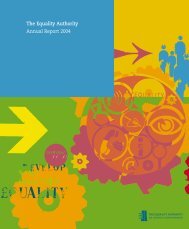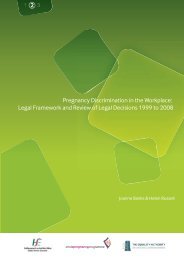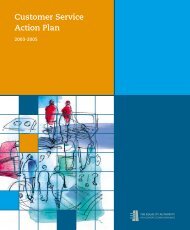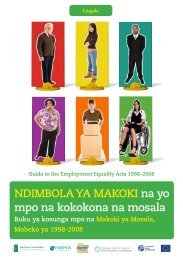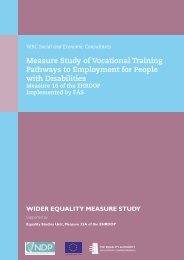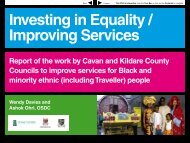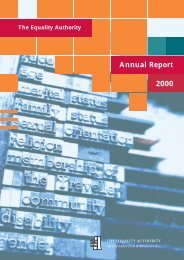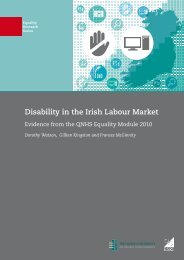Equality and Diversity - Building a Culture of ... - Equality Authority
Equality and Diversity - Building a Culture of ... - Equality Authority
Equality and Diversity - Building a Culture of ... - Equality Authority
Create successful ePaper yourself
Turn your PDF publications into a flip-book with our unique Google optimized e-Paper software.
Activity two<br />
Who is most likely to suffer<br />
from Discrimination?<br />
Divide the students into pairs. Give each<br />
pair a name card <strong>and</strong> ask them to think<br />
back to the last two classes <strong>and</strong> use what<br />
they learned there <strong>and</strong> from the h<strong>and</strong>out on<br />
Discrimination <strong>and</strong> Harassment to decide<br />
how likely the person on their card is to<br />
suffer discrimination in today’s society.<br />
give them an opportunity to question this.<br />
Then ask all the students st<strong>and</strong>ing in each space<br />
to compare their reasons for assuming levels <strong>of</strong><br />
discrimination <strong>and</strong> to identify two key reasons<br />
that they agree on.<br />
Record the groups which the students have<br />
placed at each level, <strong>and</strong> their key reasons on<br />
the board <strong>and</strong> ask the students to copy these<br />
into their folders.<br />
There are 4 levels <strong>of</strong> likelihood <strong>of</strong> people being<br />
discriminated against. They are:<br />
Extremely likely<br />
Fairly likely<br />
Fairly unlikely<br />
Extremely unlikely<br />
Give the students about five minutes to make<br />
a decision <strong>and</strong> to come up with at least two<br />
reasons for their decision. They should record<br />
the reasons in their folders.<br />
Finish with a short class discussion on<br />
the fact that they made their decisions<br />
on the basis <strong>of</strong> just one aspect <strong>of</strong> each<br />
person’s identity. Everyone has many<br />
aspects to their identity <strong>and</strong> people can be<br />
discriminated against on several grounds<br />
at the one time – for example, a woman<br />
with a disability could be discriminated<br />
against on grounds <strong>of</strong> gender <strong>and</strong><br />
disability, or a Turkish Muslim on grounds<br />
<strong>of</strong> ethnicity <strong>and</strong> religion. Encourage them<br />
to draw out the significance <strong>of</strong> multiple<br />
grounds for discrimination <strong>and</strong> the level <strong>of</strong><br />
inequality that can result.<br />
The next step is to visually show the class<br />
the groups which fall into each category,<br />
through asking the students to st<strong>and</strong> in a space<br />
representing the level <strong>of</strong> discrimination they<br />
envisage. This can be done by naming each<br />
corner <strong>of</strong> the classroom as one <strong>of</strong> the four levels<br />
<strong>and</strong> placing one <strong>of</strong> the large signs on the wall,<br />
or, if you have space, creating a spectrum across<br />
the front <strong>of</strong> the classroom. Ask each pair, in<br />
turn, to hold their card up so that it can be read<br />
by the others <strong>and</strong> to st<strong>and</strong> in the appropriate<br />
space. R<strong>and</strong>omly ask a number <strong>of</strong> the pairs to<br />
explain why they choose that level <strong>of</strong> likelihood.<br />
If anyone challenges where others are st<strong>and</strong>ing,<br />
"Everyone has<br />
many aspects to<br />
their identity<br />
<strong>and</strong> people can<br />
be discriminated<br />
against on<br />
several grounds<br />
at the one time"<br />
82 SECTION 4 EQUALITY AND THE LAW




